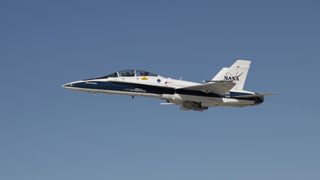
NASA Armstrong Flight Researcher Center pilot Jim Less flying one of the agency’s F/A-18 Hornet jets.
(Image credit: NASA/Carla Thomas)
Before NASA’s new X-59 supersonic jet can break the sound barrier, scientists had to record equivalent sonic booms to use for reference.
Test pilots with NASA’s Armstrong Flight Research Center took to the skies high above the Southern California desert near the U.S. Air Force’s Edwards Air Force Base in order to generate “thumps” the X-59 “Quesst” supersonic jet is expected to produce. Unlike a typical thunderous sonic boom, the sound of the X-59 breaking the sound barrier is projected to be similar to a car door slamming as heard from indoors.
To simulate this sound, NASA’s test pilots flew the agency’s F-15D Eagle and F/A-18 Hornet support aircraft over a system of microphones installed at 10 ground stations spread across 30 miles (48.3 kilometers) of the desert. By performing inverted (upside-down) dives, the jets were able to produce “softer” sonic booms to be compared against those expected to be produced by the X-59, according to NASA.
Related: NASA unveils its revolutionary X-59 Quesst ‘quiet’ supersonic jet (photos, video)
NASA’s F/A-18 and F-15 jets are commonly used as chase planes, meaning they provide a way to monitor research flights of other aircraft and vehicles from the air. Both aircraft feature two-seat cockpits, allowing for both a pilot and a photographer or videographer to fly onboard.

Three NASA F-15 jets on the back ramp at NASA’s Neil A. Armstrong Flight Research Center. Left to right: “2nd to None” (F-15D #897), “Mr. Bones” (F-15D #884), and workhorse F-15B #836. (Image credit: NASA/Lauren Hughes)
These recent tests using the agency’s “fighter” jets were the third phase of what NASA calls the “Carpet Determination in Entirety Measurements flights,” or “CarpetDIEM.”
CarpetDIEM is designed to validate upgraded ground recording systems; the agency says both “loud and soft” sonic booms were produced and recorded in order to verify these recording systems that NASA will use during X-59 testing.

One of 10 ground recording stations set up along a 30-mile stretch of desert to record sonic booms during the third phase of the of CarpetDIEM, Carpet Determination in Entirety Measurements flights. (Image credit: NASA/Steve Freeman)
In addition to the microphone ground stations, scientists at Armstrong Flight Research Center installed three weather towers and a sonic anemometer (that measures wind speed and direction) to collect weather and atmospheric data that can be correlated with the recordings of sonic booms that the F-15D and F/A-19 produced.

A weather tower and a sonic anemometer used to collect weather and atmospheric data while recording sonic booms generated by an F-15 and an F-18 from NASA’s Armstrong Flight Research Center. (Image credit: NASA/Steve Freeman)
NASA’s testing plan will involve flying the X-59 over several U.S. cities to collect data about the quieter boom, or “thump,” it makes when breaking the sound barrier. The agency also wishes to learn how the public perceives and responds to the craft, according to a statement.

NASA’s X-59 quiet supersonic research aircraft sits on the apron outside Lockheed Martin’s Skunk Works facility at dawn in Palmdale, California. (Image credit: Lockheed Martin Skunk Works)
If all goes to plan, NASA will take the data it collects during its X-59 testing campaign to the Federal Aviation Administration and international regulators to potentially amend current regulations that prohibit supersonic travel over land. The agency says supersonic overland flight could not only enable faster commercial travel, but also shorten response times for medical emergencies and speed up shipping.

The Lockheed Martin-built NASA X-59 Quesst. (Image credit: Lockheed Martin Skunk Works)
One of the ways the X-59 is able to break the sound barrier without generating a deafening sonic boom is through its unique geometry. The sharp, elongated nose section of the jet measures 38 feet (11.5 meters) in length, while the entire aircraft comes in at 99.7 feet long (30 m).

This image shows a close up of the cockpit view of the eXternal Vision System (XVS) that will be placed in the X-59. Instead of a front facing window, the pilot will use these monitors for forward facing visibility. (Image credit: Lockheed Martin Photography By Garry Tice)
The long, duck-bill-like nose also means pilots won’t be able to see out of the front of the aircraft — in fact, it doesn’t even feature a forward wind screen. Instead, the X-59 uses a forward-facing, closed-circuit camera and augmented reality display known as the External Vision System, or XVS.
The X-59 is designed to reach a speed of Mach 1.4, or 925 mph (1489 kph) while flying at an altitude of 55,000 feet (16,764 m) and is powered by a single engine built by General Electric Aviation.
Join our Space Forums to keep talking space on the latest missions, night sky and more! And if you have a news tip, correction or comment, let us know at: [email protected].
Breaking space news, the latest updates on rocket launches, skywatching events and more!
Brett is curious about emerging aerospace technologies, alternative launch concepts, military space developments and uncrewed aircraft systems. Brett’s work has appeared on Scientific American, The War Zone, Popular Science, the History Channel, Science Discovery and more. Brett has English degrees from Clemson University and the University of North Carolina at Charlotte. In his free time, Brett enjoys skywatching throughout the dark skies of the Appalachian mountains.
>>> Read full article>>>
Copyright for syndicated content belongs to the linked Source : Space.com – https://www.space.com/nasa-x-59-sonic-boom-f-18-recording































